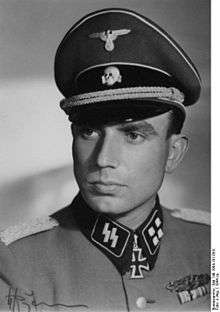Otto Weidinger
| Otto Weidinger | |
|---|---|
 | |
| Born |
27 May 1914 Würzburg, German Empire |
| Died |
10 January 1990 (aged 75) Aalen, Germany |
| Allegiance |
|
| Service/branch |
|
| Years of service | 1934–45 |
| Rank | Obersturmbannführer |
| Battles/wars | World War II |
| Awards | Knight's Cross of the Iron Cross with Oak Leaves |
Otto Weidinger (27 May 1914 – 10 January 1990) was a member of the Waffen-SS in Nazi Germany and a regimental commander in the SS Division Das Reich during World War II. In this capacity, he was involved in the Oradour massacre in France in June 1944. He was the author of a revisionist account of the division's history, produced under the auspices of HIAG, a Waffen-SS lobby group in post-war West Germany.
World War II
Born in 1914, Otto Weidinger enlisted in the SS-Verfügungstruppe (SS-VT) (precursor to the Waffen-SS) in April 1934. His first assignment was as a camp guard at the Dachau concentration camp. With the SS Division Das Reich, he participate in the invasion of Poland and in the Battle of the Netherlands. During Operation Barbarossa, the invasion of the Soviet Union, he served on the divisional staff. In 1943, Weidinger was posted to the SS Regiment "Germania" and took part in the Battle of Kursk. In April 1944, Weidinger was awarded the Knight's Cross of the Iron Cross. He was promoted to command of the 4th SS Panzer-Grenadier Regiment "Der Führer" stationed in Normandy coastline.
When World War II ended, Weidinger was held at the Dachau internment camp administered by the US Army. In August 1947, he was transferred to French custody, where he was charged with war crimes and stood trial in 1951. Weidinger was acquitted by a military court in Bordeaux in June 1951. At the trial of the perpetrators of the Oradour-sur-Glane massacre in Bordeaux in January 1953, Weidinger was a witness for the defense.
Post-war apologia
From 1967 to 1982, Weidinger wrote the history of Regiment "Der Führer" and a six-volume history of "Das Reich" published by the right-wing Munin Verlag, which was owned by HIAG, a Waffen-SS lobby group. The narrative was extensive and strove for a so-called official representation of the division's history, backed by maps and operational orders. "No less than 5 volumes and well over 2,000 pages were devoted to the doings of the 2nd Panzer Division Das Reich", writes the military historian S.P. MacKenzie.[1]
Munin Verlag's expressed aim was to publish the "war narratives" of former Waffen-SS members, and their titles did not go through the rigorous fact-checking processes common in traditional historical works; they were revisionist accounts unedited by professional historians and presented the former Waffen-SS members' version of events.[2] The Das Reich divisional history, like other HIAG publications, focused on the positive, "heroic" side of National Socialism. The French author Jean-Paul Picaper, who studied the Oradour massacre, notes the tendentious nature of Weidinger's narrative: it provided a sanitized version of history without any references to war crimes.[3]
In 1984, Weidinger self-published a revisionist account of the Tulle massacre, Tulle and Oradour. A German-French tragedy. Re-issued after his death, by the right-wing Nation und Europa, it was subsequently banned in France.
Awards
- Iron Cross (1939) 2nd Class (15 November 1939) & 1st Class (25 July 1940)[4]
- German Cross in Gold on 26 November 1943[5]
- Knight's Cross of the Iron Cross with Oak Leaves and Swords: Knight's Cross on 21 April 1944; Oak Leaves on 26 December 1944[6]
- Swords on 6 May 1945 (?)—No evidence of the award can be found in the German Federal Archives. The award was unlawfully presented by Sepp Dietrich, commander of the the 6th Panzer Army. Weidinger was member of the Association of Knight's Cross Recipients.[7]
References
Citations
- ↑ MacKenzie 1997, p. 138.
- ↑ Wilke 2011, p. 379.
- ↑ Picaper 2014.
- ↑ Thomas 1998, p. 424.
- ↑ Patzwall & Scherzer 2001, p. 501.
- ↑ Scherzer 2007, p. 773.
- ↑ Scherzer 2007, p. 184.
Bibliography
- MacKenzie, S.P. (1997). Revolutionary Armies in the Modern Era: A Revisionist Approach. New York: Routledge. ISBN 978-0-415-09690-4.
- Parker, Danny S. (2014). Hitler's Warrior: The Life and Wars of SS Colonel Jochen Peiper. Boston: Da Capo Press. ISBN 978-0-306-82154-7.
- Patzwall, Klaus D.; Scherzer, Veit (2001). Das Deutsche Kreuz 1941 – 1945 Geschichte und Inhaber Band II [The German Cross 1941 – 1945 History and Recipients Volume 2] (in German). Norderstedt, Germany: Verlag Klaus D. Patzwall. ISBN 978-3-931533-45-8.
- Picaper, Jean-Paul (2014). Les Ombres d'Oradour: 10 Juin 1944 [The Shadows of Oradour: 10 June 1944] (in French). Paris: Éditions l'Archipel. ISBN 978-2-8098-1467-5.
- Scherzer, Veit (2007). Die Ritterkreuzträger 1939–1945 Die Inhaber des Ritterkreuzes des Eisernen Kreuzes 1939 von Heer, Luftwaffe, Kriegsmarine, Waffen-SS, Volkssturm sowie mit Deutschland verbündeter Streitkräfte nach den Unterlagen des Bundesarchives [The Knight's Cross Bearers 1939–1945 The Holders of the Knight's Cross of the Iron Cross 1939 by Army, Air Force, Navy, Waffen-SS, Volkssturm and Allied Forces with Germany According to the Documents of the Federal Archives] (in German). Jena, Germany: Scherzers Miltaer-Verlag. ISBN 978-3-938845-17-2.
- Thomas, Franz (1998). Die Eichenlaubträger 1939–1945 Band 2: L–Z [The Oak Leaves Bearers 1939–1945 Volume 2: L–Z] (in German). Osnabrück, Germany: Biblio-Verlag. ISBN 978-3-7648-2300-9.
- Wilke, Karsten (2011). Die "Hilfsgemeinschaft auf Gegenseitigkeit" (HIAG) 1950–1990: Veteranen der Waffen-SS in der Bundesrepublik [HIAG 1950–1990: Waffen-SS veterans in the Federal Republic] (in German). Paderborn: Schoeningh Ferdinand GmbH. ISBN 978-3-506-77235-0.